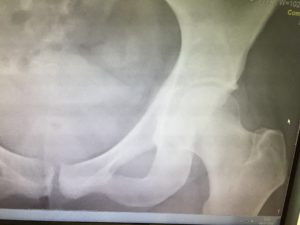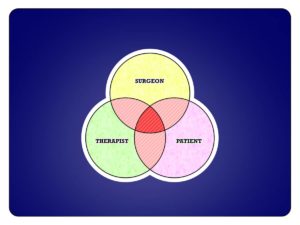With tongue in cheek, I firmly believe that, as a physio, I should be exempt from being injured like a normal person. After all, I spend my life fixing other people’s injuries, so surely karma should be on my side – or so my irrational brain tells me. In practice, it doesn’t work like that – I pick up injuries fairly regularly, largely because I spend so much of my time puzzling out why my patients are breaking themselves, that I don’t put enough time and energy into maintaining my own body, and to noticing the warning signs when things are starting to go a bit wonky. But as a physio, the advantage I have when I do get injured, is that I know who to see and what to do about it. This is the story of how I injured my hip recently, and how I’m using my knowledge and contacts to recover.
I play quite a lot of tennis. In winter, that’s more like twice a week; but during the summer season, I aim to play three times a week: one training session, one weekday match and one weekend match. I’m a decent player: I captain my county Over 40s team, I play for several clubs, and despite shoulder surgery in my 20s, my first serve kicks in at around 90mph.
So I was gutted when, at the start of July, I landed on my left foot after a serve, and felt something go CRUNCH in my left hip.
I finished (and won) the match – it was a county match and I was in the lead – but by the end, I was really struggling; and when I got home and tried to get out of my car, I got stuck and nearly cried. I was convinced that I had torn the labrum of my left hip: a circular rim of cartilage that encloses the hip socket, turning it from a saucer shape into a bowl.
I thought about what I would tell my patients to do in a similar situation, and about what the hip surgeons I work with would ask; and so I took myself off to A&E the next morning to ask for an X-ray.
The A&E nurse was less understanding than I’d hoped; but eventually she did agree to order an X-ray for me. Getting an X-ray was important, because it’s one of the vital elements when it comes to diagnosing Femoroacetabular Impingement or FAI, otherwise known as a pinching hip – a structural issue which can predispose people to tearing the labrum.
The nurse told me that the A&E consultant couldn’t see anything wrong with the X-ray; but they would have been looking for a fracture, not for FAI, so I snapped a photo of the X-ray on my phone, to show my orthopaedic consultant.
I then got one of my team to refer me for a private MRI scan, as this can show damage to soft tissue such as cartilage or ligament, as well as inflammation. Again, the radiologists who report on MRI scans are not always hip specialists, so I made sure to get a copy of the disk for my orthopaedic consultant, rather than purely relying on the radiologist’s report.
Finally, I contacted my favourite hip surgeon, Paul Jairaj, told him what had happened and asked him for help. He was fantastic, and booked me straight into an unofficial clinic. I’ve worked with him a lot, and knew I would be able to trust him.
My symptoms weren’t classic – one thing I’ve learned is that physios never have classic symptoms. My hip kept catching and was painful when I turned (classic) but I had a fairly normal and pain free range of movement, with the hip only hurting when I put weight through my left leg, or took weight off my left leg (not classic!)
Between them, Paul and the radiologist, through a combination of physical assessment, discussion about what I’d been doing to hurt myself and what the pain was like, and the MRI images, worked out that I had a small tear in my labral cartilage, an inflamed hip joint, and a strained adductor (groin) muscle. Fortunately, I don’t have a severe case of FAI. No wonder my symptoms weren’t classic – too many overlapping issues! But in a way, this was good news: no need for immediate surgery (I won’t need it unless the cartilage tear gets worse) and therefore a good chance of it responding to physio and rehab.
First of all, we had to calm the joint down and reduce the inflammation. I developed a new love for ibuprofen and was religious about taking it (the anti-inflammatory effect is cumulative, so regular intake is important) but also got my fantastic team to treat me, to reduce the muscle spasm around my hip joint and thus speed up the process.
Next it was time to work out exactly why my labrum had torn, and therefore how I could minimise the risk of tearing it further. Cartilage doesn’t heal, so this will be a case of managing it and keeping me symptom free – surgery can be amazing if you really need it, but the risks are such that you’d only have it if you’d exhausted the non-surgical options – just ask Andy Murray!
When they assessed me, my team inevitably spotted all the little postural kinks that I had been too busy to notice. My left hip was slightly internally rotated, but my torso rotated slightly to the left – so my hip cartilage was under pressure even before I added a serve into the mix, which compresses the cartilage further (and forcefully, at pace).
They also picked up issues with my service action itself. 16 years ago, I tore the rotator cuff tendons in my right shoulder and ended up having surgery 9 months later, after the shoulder didn’t heal. I’ve had an excellent surgical result – I can play tennis and my shoulder doesn’t hurt – but I’ve never regained a full range of rotation; and as this is vital to being able to serve, I’ve always had to compensate for that deficiency with the rest of my body – cue more pressure and strain on my left hip and groin.
Finally, my glutes (buttock muscles) on the left side were weaker and less responsive than my right side. The glutes’ job is to cushion and control the hip and groin, so restoring function there has to be a priority.
Effectively, my labrum had buckled under the strain of a perfect storm.
The team – including me – are taking action. After all, I don’t want to end up under the surgeon’s knife if I can help it. Much as I trust Paul and his colleagues, post operative rehab is often long and painful (certainly more so than physio without surgery) and there’s always a risk – however small, especially in the hands of an excellent surgeon – of infection and disaster.
So – I am doing all my release exercises to reduce local muscle spasm. I’m getting hands-on treatment and using the Mobiliser to help with my thoracic mobility. I’m working on the range of movement in my shoulder, to reduce the impact of serving on my hip when I return to tennis; and I’m working to get strong through the new range. And if you ever stand behind me, try not to look down – I’m constantly activating my left glutes, to improve their responsiveness, mass and tone; and as my hip calms down, I’ll be working on my service technique with my coach, to try to rebalance the impact on my right shoulder and left hip.
As I have explained before, an optimal result comes from a team effort: surgeon (in this case to diagnose the structural issues and decide not to operate), therapists (to analyse and treat the underlying mechanical causes of the structural issues) and patient (to do the exercises). And I am confident that, as long as I keep playing my part and don’t allow my body to fall back into old habits, that I will get back on court comfortably, with improved technique and less stress on my hip.
Do you have an injury that’s just appeared for no obvious reason? Do you understand why you have it and what to do about it? If not – call my team on 0207 175 0150 to book an assessment, and let me help you to work out why your posture and movement habits are putting you at risk – and then put together an action plan so that you can injury-proof yourself for the long term.


